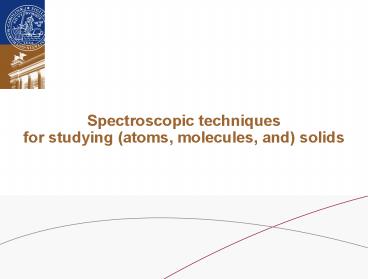Spectroscopic techniques for studying atoms, molecules, and solids PowerPoint PPT Presentation
1 / 19
Title: Spectroscopic techniques for studying atoms, molecules, and solids
1
Spectroscopic techniquesfor studying (atoms,
molecules, and) solids
2
MAX-lab visit
- Suggested date
- 2nd October, 17.00
- Meeting place Department of Physics, Reception
3
Regalskeppet Vasa The Vasa warship
- Discuss and try to understand your
experimental method! - Each group should explain their method to the
other students, using the whiteboard and/or
overhead transparencies. You should also outline
what has been achieved using the method in
conjunction with the Vasa research project. - Hints
- What is/do you think is the principle of the
method? - How does the method work (practically)? (if you
dont know make a suggestion) - What kind of information do you obtain using the
method? - What kind of data do you get out?
- Why did one choose the particular method?
- What are the methods advantages and
disadvantages?
4
Photoemission spectroscopy
5
Photoemission spectroscopy (Photoelectron
spectroscopy)
PES Photoemission Spectroscopy Photoelectron
Spectroscopy XPS X-ray Photoelectron
Spectrocopy UPS Ultraviolet Photoelectron
Spectroscopy
6
Reminder characteristic x-rays in PIXE
7
Electron binding energies
8
Photoemission spectroscopy an example
9
Vasa XPS results
XPS Elemental and chemical analysis, primarily
of surfaces, but at high primary energies also of
the bulk.
Sandström et al., Nature 415 (2002) 893.
10
X-ray absorption spectroscopy
11
X-ray absorption spectroscopy
XANES X-ray Absorption Near Edge Structure
NEXAFS Near Edge X-ray Absorption Fine
Structure ( XAS X-ray Absorption Spectroscopy)
12
How to measure x-ray absorption spectra
True absorption measurement
Electron yield or fluorescence yield measurement
(b)
(a)
Measure I1(hn)-I0(hn).
The number of decays (as a function of photon
energy) is (exactly) proportional to the number
of excitations (as a function of photon energy)!
Wood from the Vasa warship, G. Almkvist, Dissertat
ion SLU, 2008
13
Reminder characteristic x-rays in PIXE
14
Probability of fluorescence and Auger decays
Fluorescence decay probability wf
Auger decay probability wa
Sum rule for Auger and fluorescence decay wf
and wf
wf wa 1
X-ray Data Booklet, Thompson and Vaughan
(Eds.), Lawrence Berkely National
Laboratory, available from http//xdb.lbl.gov
15
X-ray emission spectroscopy
16
Reminder characteristic x-rays in PIXE
17
X-ray emission spectroscopy
XRF X-ray fluorescence spectroscopy XES
X-ray emission spectroscopy
M. Hollas, Modern Spectroscopy, John Wiley
Sons, New York 2004.
18
X-ray emission spectraComparison of different
ways of exciting
PIXE excitation by protons or particles in the
MeV range
advantages
particles/protons easy to focus, even down to
small beam sizes
low bremsstrahlung background
disadvantages
very low sensitivity to low-Z elements
accelerator necessary
XRF/XES excitation by electrons in the keV range
advantages
electron easy to focus, even down to small beam
sizes
most surface sensitive
lab source
disadvantages
very low sensitivity to low-Z elements
high bremsstrahlung background
XRF/XES excitation by photons (typically from
soft x-rays to g-rays)
advantages
lab source possible
low background
disadvantages
very low sensitivity to low-Z elements
photons hard to focus down to small beam sizes
19
Regalskeppet Vasa The Vasa warshipRecent
results
- Iron rather than sulphuric acid seems to be the
real problem - Iron ions catalyse the degradation of the
cellulosis - Two recent PhD theses, both available on the
internet - Gunnar Almkvist, Sveriges lantbruksuniversitet,
Uppsala, 2008 - Yvonne Fors, Stockholms universitet, 2008

